History of the West End of London
By Staff Writer
Sunday 3rd September 2023
Ask anyone about what comes to mind when they think of the West End of London and they’ll likely tell you that it’s the prime destination for the best in theatre shows and a night on the town. Now, it is both of those things, but it is so much more than that and here we’re going to take a brief look at just some of the history that came to pass in the area to make it what it is today.
By reading on, you’ll realise that it is most certainly a fantastic place to catch a show and enjoy a good meal, but also an area of London’s capital that’s seen its fair share of tumult. So if you’re ready, let’s take a step back a few hundred years into London’s murky past.
West of the City, North of the River Thames
The term ‘the West End’ is an abbreviation of The West End of London and it describes a specific area of Central London that’s to the North of the famous River Thames. Geographically speaking, the area is comprised of Camden and Westminster and it sits, unsurprisingly, to the West of the centre of the centuries-old capital. Interestingly, the West End became a popular locale with the rich folk of medieval London, as the prevailing wind there usually blew downwind, keeping the choking smoke of central London away.
It was also a locality that was home to the Palace of Westminster – a royal seat at the time and now home to the iconic houses of parliament. Over the course of 300 years, covering the 17th to the 19th century, more and more palaces and townhouses for the rich elite were built, displacing what had been poor communities in Covent Garden, Holborn and Seven Dials.
In truth, before the elite of London became interested in the area, there wasn’t much to speak of in London and the catalyst of change and development came in the form of the Great Fire of London in 1666, which famously started in Pudding Lane, near London Bridge. This pivotal moment history proved to be a turning point for the West End and without it, we might see a very different look to the district today.
Leicester Square
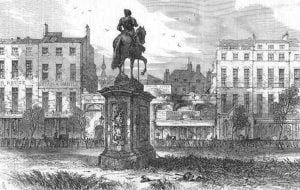 With Covent Garden and its bustling markets to the East and Piccadilly Circus and all of its attractions to the West, Leicester Square sits right in the heart of the West End. Like much of the area, it had much humbler beginnings, even being noted as a place to simply dry clothes and graze horses back in the 17th century. A map exists that’s carved from wood named ‘Civitas Londinium’ and it portrays the area being something of a grassy meadow – a far cry from the bright lights and busy streets we see today.
With Covent Garden and its bustling markets to the East and Piccadilly Circus and all of its attractions to the West, Leicester Square sits right in the heart of the West End. Like much of the area, it had much humbler beginnings, even being noted as a place to simply dry clothes and graze horses back in the 17th century. A map exists that’s carved from wood named ‘Civitas Londinium’ and it portrays the area being something of a grassy meadow – a far cry from the bright lights and busy streets we see today.
It wasn’t until 1670 when the pedestrianised square was laid out and given its official name after the 2nd Earl of Leicester and his residence – Leicester House. Over the ensuing years, it turned into a residential area populated primarily by the middle class, with Karl Marx, Joshua Reynolds and Frederick, Prince of Wales noted as some of its more famous inhabitants.
This upward mobility didn’t last forever, however, as Leicester House was pulled down at the end of the 1700s and the area became much more like its previous down-market self. In its place, dozens of retail establishments were created, followed by a multitude of theatres over the next 150 years. Many of the cinemas that exist in Leicester Square today are housed in the same buildings created during this period.
It’s certainly true to say that the face of Leicester Square has experienced a great amount of change in its long history.
Piccadilly Circus
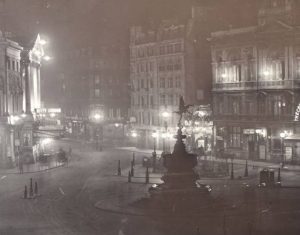
The junction itself was built back in 1812 and because of its prime location and proximity to so many top-class entertainment venues, it has become a tourist destination in its own right. The Piccadilly part of the junction’s name has its origins back in the 17th century, as Roger Baker, a tailor who made his fortune making Piccadills (a popular frilled collar fashion item of the day) lived in the area, and so the full name that’s so familiar to so many today, was born.
The locale is also home to the Criterion Theatre, the London Pavilion Theatre and the Shaftesbury Memorial Fountain Statue, which ironically is best known for being something that it’s not. Many believe the monument that was built in 1892 to be Eros, the Greek God of chaos, but whilst it does feature a winged cherubic figure brandishing a bow and arrow, it’s actually something entirely different. It’s actually a statue of Anteros and was erected to commemorate the philanthropic work of Lord Shaftesbury, a man who challenged the concept of child factory labour, so common at the time.
Covent Garden
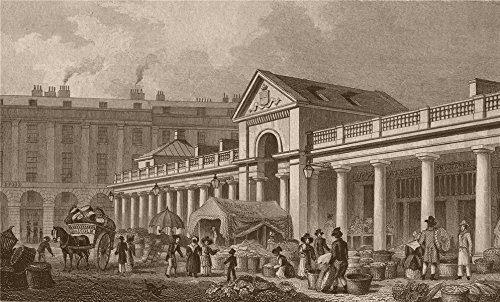
It stayed that way until 1536 when King Henry VIII – a staunch opponent of the Catholic Church – dissolved England’s monasteries, seizing the land in the process. The King gifted the land to one of his friends, with the area changing hands a number of times before it finally came into the possession of John Russell, whose official title was the 1st of Bedford. After unsuccessfully trying to sell the land in the early 1600s, it passed to the 4th Earl of Bedford – Francis Russell.
It was Francis that began the area’s transformation into what it is today, as, in an attempt to create an income from the land, he commissioned Inigo Jones, a noted Royal architect, to build a square development of homes ‘fit for gentlemen with ability’. The ensuing square was the first piazza of its kind in England’s Capital city and it’s widely regarded as being the inception of the famous thoroughfare that exists today.
Although the locale that has since become known as Covent Garden was still relatively sparsely populated and by the time the mid-1600s came around, markets began to appear there with increasing regularity. It was perhaps the fact that it was only frequented by wealthy folk that it escaped the worst effects of the plague in 1665 and it was fortunate enough to remain untouched by the aforementioned Great Fire of London that claimed so much of the city just a year later.
A massive influx of people to Covent Garden occurred due to 7/8ths of the homes in London being destroyed and this caused a rapid expansion in commerce and trade, leading to King Charles II granting Covent Garden a Royal Charter in 1670. The Great Fire of London was a traumatic event for so many of London’s inhabitants, but without it, Covent Garden almost certainly wouldn’t exist as it does today.
Trafalgar Square
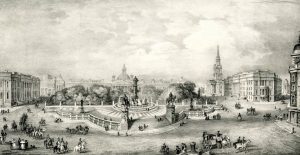
After King George IV relocated the King’s Mews to Buckingham Palace, the area was redeveloped by John Nash to mark Nelson’s achievements, however, it was some years before it was completed. By 1844 the square saw one of its main features installed – the 169-foot tall column with Lord Nelson sitting at the very top. The monument, surrounded by four majestic lions is one of several monuments in Trafalgar square, with the fourth plinth – vacant since the mid-1840s – now being used to display contemporary art.
Theatreland
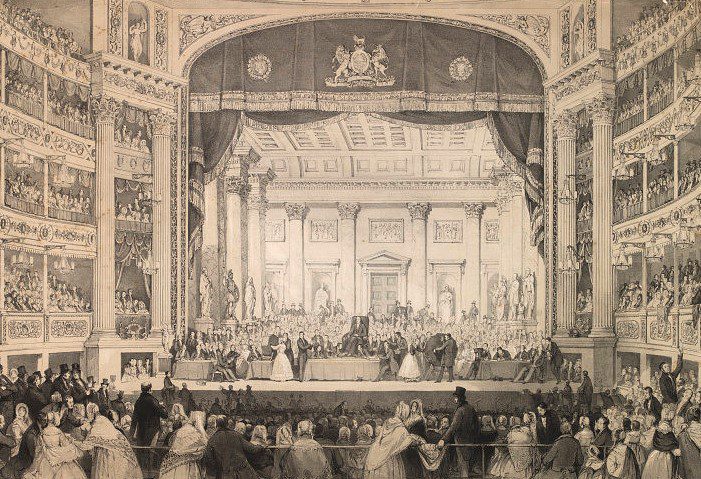
It wasn’t until 1806 that the next major theatre was built in the West End. The Sans Pareil, now known as the Adelphi Theatre was built with £10,000 of playwright John Scott’s money and the majority of the shows and entertainment performed were actually written by his daughter, Jane M Scott.
Fast forward another 83 years and we see the Garrick and Lyric Theatres open, with the Garrick being built over an old Roman river. Whilst the Lyric is the oldest theatre found on Shaftesbury Avenue, the Garrick is one of the smallest you’ll find in the area.
By the time the 20th century arrived, Theatreland was in full swing, with the longest-running show in theatre history – the Mousetrap – opening for the first time in 1952 at the Ambassadors Theatre. In its 60+ years, more than 10 million people have seen the show and this number is still rising, as it’s still going strong today. When you also consider that the West End is the home of other epic shows like Les Miserables opening in 1986 and the Phantom of the Opera in 1990, it’s clear that the area has been and still remains as a hub of theatrical excellence. It will likely still be going strong in another 100 years time.
Savile Row
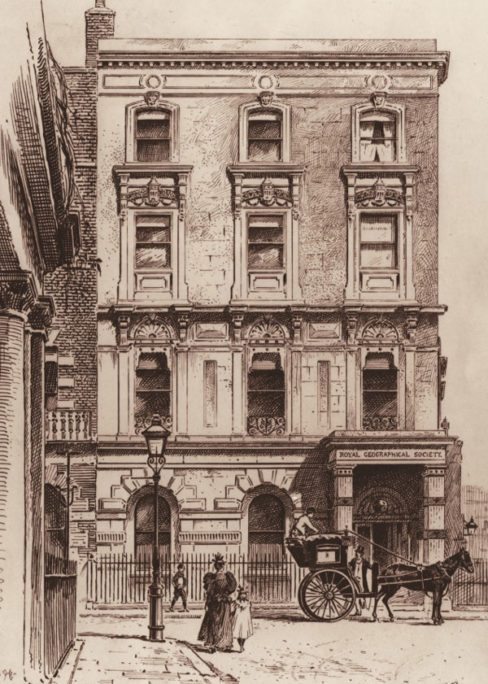
Once going by the name of Savile Street, it originally formed part of the Burlington Estate development that was built over the course of four years and completed in 1735. The architecture in the area has a strong Anglo-Irish influence coming from the Boyles, whose males provided the lineage for the Earls of Burlington a.k.a. The Duke of Devonshire. Designed primarily by architect Henry Flitcroft, this famous street was initially home to the officers from England’s military, with politician, William Pitt the Younger one of its most notable residents.
It wasn’t until the turn of the 19th century that the street became associated with the tailoring profession with the adjacent Cork Street being the first to house professional tailors and Savile Row following suit shortly after. By the time the late 1840s came to pass, Savile Row had truly established itself, with the likes of Henry Poole – inventor of the tuxedo – extending his premises on Burlington Street to include an entrance on Savile Row.
Since that day Savile Row has remained known as the home of fine tailoring and even once was responsible for manufacturing the dress uniforms for the officers of the British military throughout the First World War. Today you’ll find the likes of Henry Poole & Co, Gieves & Hawkes and Cad & The Dandy as some of the most prestigious names in the tailoring industry.
Oxford Street
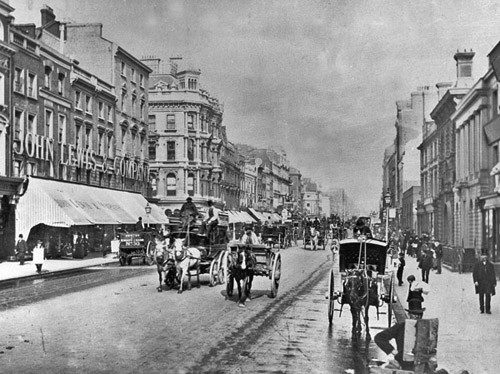
Oxford Street started off life as part of a Roman Road known as ‘Via Trinobantina’ that linked Hampshire and Essex and it cut right through the heart of London. Going on to be known as Tyburn Road during the Middle Ages when it was best known for being the location of public hangings, it would finally become known as Oxford Street in the 1700s when it began to move from residential to commercial use.
Initially attracting low-end market and street traders, prostitutes and confidence tricksters, Oxford Street would slowly move upmarket over the next century or so, with the first major department stores like John Lewis and Selfridges appearing in the early 1900s. What you’ll notice walking down Oxford Street today is that despite being home to the cream of retail in the UK, they sit side by side with less salubrious retail outlets, showing that not everything has changed since those early days.
The Blitz of World War II hit London hard and Oxford Street did not get off lightly. Several established department stores, including big names like John Lewis, saw their buildings levelled by German bombing raids, resulting in them being completely rebuilt from the bottom up. As a testament to the undying spirit of resilience and rebirth, Oxford Street has bounced back to its present-day status as one of the most popular tourist and shopping destinations in the world.
Regent Street
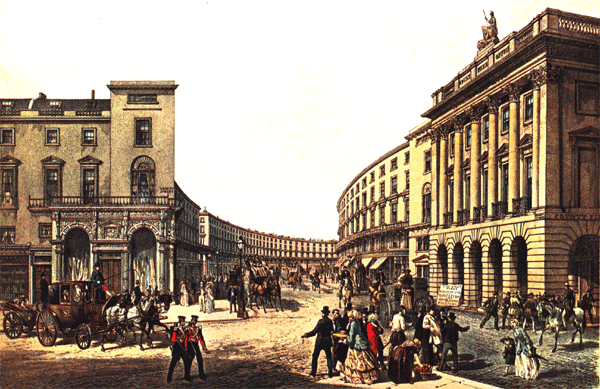
Noted Georgian architect John Nash worked with property developer James Burton to lay out the foundations of modern-day Regent Street, which was named after the then Prince Regent, George IV. Running from St James’s to Waterloo Place, this major thoroughfare passes through Oxford Circus and Piccadilly Circus to All Souls Church.
Representing an early form of town planning, the layout of Regent Street was finalised in the mid-1820s and it is one that remains to this day in the original dimensions set down by Burton and Nash. All the buildings have been pretty much rebuilt since then but this has allowed the area to become known as a place for serious shoppers to visit. It might be a lot younger than Oxford Street, but Regent Street can certainly be spoken about in the same breath when talking about premium retail therapy.
Bond Street
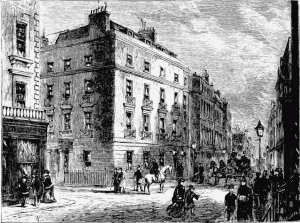
Technically speaking, Bond Street is made up of two parts; New Bond Street to the North and Old Bond Street to the south. However, whilst this still remains an empirical fact, it’s not used in common parlance. The road has a history that goes back to the early 18th century at a time when the area was still but fields in the Piccadilly area that encircled Clarendon House
Sir Thomas Bond was the driving force behind the building of Bond Street and by the time the 18th century came to an end, it had become a preferred socialising spot by Mayfair’s upper-class community. The area enjoyed this popularity amongst the well-to-do, but it went on to experience a period of retail decline with the emergence of the might of Oxford Street.
Whilst it might lag slightly behind Oxford Street in terms of sheer numbers, it still attracts large amounts of retail visitors thanks to the presence of major department stores like Tiffanys and Fenwick, with the added benefit of being the home to major auction houses like Bonham and Sotheby’s. Some of the most expensive items ever sold have passed through Sotheby’s, like the CTF Pink Star diamond which went for almost £58m. Its position as a prestigious area of the West End is assured, making Bond Street buildings some of the most valuable real estate in the world.
Carnaby Street
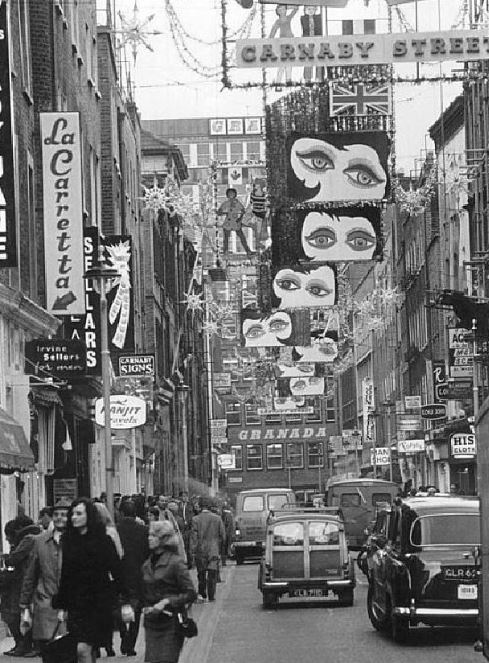
The street derives its name from the very first house that existed there – Karnaby House. The street itself was laid out by Richard Tyler – a noted 17th century bricklayer and it was also during the 17th century that Carnaby Street was home to victims of the Great Plague, as it became the first places in London to have a ‘Pest House’ or ‘Plague House’ where those afflicted with the lethal illness were housed.
Moving forward to the 1720s, Carnaby Street was repurposed into a meat, vegetable and fish market which began life as Lowndes Market, before being renamed to Carnaby Market. For more than a century, things remained very much ‘as you were’ until Regent Street’s creation in 1823 cut it and the larger area of Soho off from the prestigious London area of Mayfair.
Soho was also the location of one of the most notable and unfortunate events in history, as the major cholera outbreak of 1854 started there. A single water pump in Broadwick Street, just a short skip and a jump from Carnaby Street, was the source of the outbreak and it continued to infect everyone who drank from it until it was identified by epidemiologist, John Snow.
Since those dark days, Carnaby Street has grown and flourished into one of the premier fashion shopping destinations in London with Vince, the first boutique offering menswear opening in the area in the mid 1950s. This was no ordinary menswear outfitters either, as it included Jimi Hendrix, the Kinks, the Rolling Stones and the Beatles amongst its many celebrity patrons.
Today, Carnaby Street has lost none of its vibrancy and lustre and it remains a ‘must-visit’ place for anyone finding themselves in the West End of London.
Seven Dials
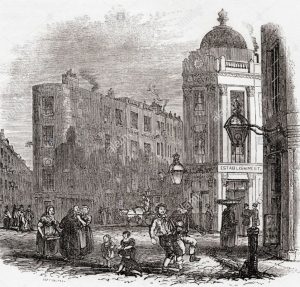
The centre of Seven Dials itself sits at a junction between four different streets; Earlham Street (formerly Little & Great Earl Street), Mercer Street (formerly Little & Great White Lyon Street), Monmouth Street (Little & Great St Andrew’s Street) and Short’s Gardens (formerly Queen Street). When it was built, Seven Dials was intended to attract upmarket residents and the pillar that still sits at the centre of Seven Dials was both constructed and designed by Edward Pierce, London’s foremost stonemason at the time.
Seen as one of the capital’s greatest monuments, the Sundial Pillar, which itself features six sundial faces, completed the design and it’s this layout that still remains today. However, the high-end vision that Thomas Neale had for the area never materialised and it descended into a slum that was primarily known for its gin retailers. Interestingly, at one time, there were seven public houses facing the monument whose vaults and cellars connected, offering a handy escape route to anyone who needed it.
Seven Dials remained in a state of poverty for over a hundred years, with many Irish workers flocking to the area in search of a cheap place to live. It wasn’t unusual at the time for large families of 6 or 7 people to live in a single room in the streets of Seven Dials, but little did residents there know that eventually, the gentrification of the area that Neale craved would be realised.
By the mid to late 19th century, the surrounding areas of Seven Dials were developed, attracting a higher class of clientele. The popularity of the West End’s theatres drew many to the locale, which slowly made the area more attractive to businesses and craftsmen, leading to many moving in and setting up shop there. Since that time, Seven Dials has been home to commerce of all shapes and sizes, with ironmongers, flower markets and restaurants appearing all across the area, as well as those interested in the occult who find meaning in the sundial symbolism of the geographical layout.
Today, Seven Dials is a commercial hive of activity and anyone walking down its streets will see plaques dedicated to some of its most notable former residents. The studios of the great Monty Python Studios were located here, as well as Brian Epstein – the former manager of the Beatles. However, although its come a long way since its poverty-stricken days in the 17th and 18th centuries, echoes of its past still remain in the architecture, much of which remains unchanged.
It may not be as well-known as some of the more salubrious areas of the West End, but it surely had a colourful history.
An Iconic Location Visited by Millions
This has been but a mere slice of the rich and varied history of the West End. We really could write page after page after page on what makes the this iconic part of London unlike any other place on earth, as there are so many notable events to cover.
The millions of people who flock to the West End are rightly dazzled by the flashing lights, high-class entertainment and top-class shopping that it offers, but there are perhaps not that many who understand the centuries of history that provide the backdrop to these modern-day wonders.
There’s an old saying by Sir Isaac Newton that states “if I have seen further it is by standing on the shoulders of giants” and it applies, at least in part to the West End of London, as without the events that have gone before, it would not be the thriving, iconic, world-renowned tourist destination that it is today.
And that absolutely should never be forgotten.


